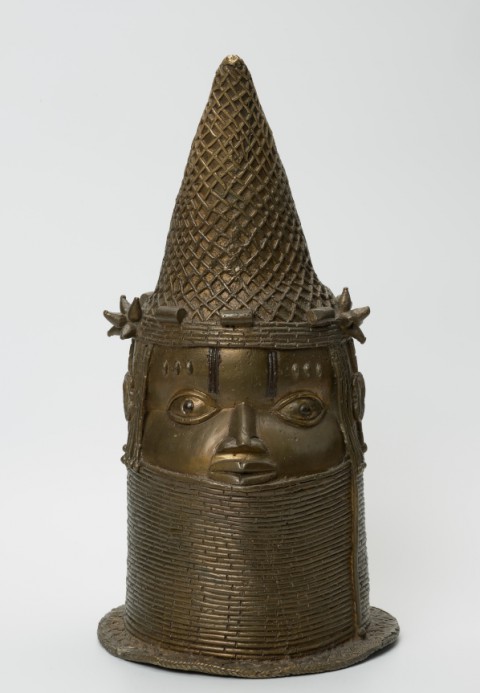The head of the Queen Mother of Benin from the collection of the National Museum in Szczecin
It is the only such work of art in Polish museums. Bronzes from Benin, one of the kingdoms of West Africa, which has survived to this day in the state of Edo in Nigeria, are figurines that – contrary to what the name suggests – were mostly cast or engraved in brass between the 16th and 18th centuries. They depict the figures of rulers and the most important events in the history of Benin. The figures are scattered around various European museums, the largest collection is in the British Museum in London.
Courtly art in the Kingdom of Benin
The cast of the head of the Queen Mother (Iyoba) is an example of the courtly art of the Benin Empire. Most likely it was made in the 18th or early 19th century in the late period of the kingdom. This is evidenced by the large size, weight and manner of presenting the Queen Mother devoid of any personal features. The casting is made of bronze using the lost wax method. Benin's courtly art shows a hierarchical and patrilineal society organised around the figure of the divine ruler (Oba). Initially, heads carved in wood were placed on the altars of ancestors. From the end of the 13th century, they were made of bronze, which was associated with the introduction of foundries to the court. The first casts were images of Oba.
The beginning of a new tradition
In the 16th century, the ruler of Esigie broke the tradition of killing the mother of the new king. He named his mother Iyoba Iyoba and placed her in the palace in Uselu. After the death of the Queen Mother, an altar was erected in her honour at the ruler's seat, and its main element was a bronze cast of the head. This tradition was followed by most of Esigie's successors, thus creating a new figural motif in Benin's courtly art.
A unique work of art
There is only one bronze head from Benin in Polish museum collections. It was given to the Szczecin museum by an unknown woman in 1977. She inherited this extraordinary work from her husband, who ran a scrap metal collection business in Wrocław just after the war. The figure is probably a remnant of the Berlin bronze exhibition that was hosted in Wrocław during World War II. A sudden shift in frontline cut off the exhibition's return to Berlin, and the exhibits were lost. Such a mysterious story is associated with this pearl of the African collection at the National Museum in Szczecin.
The project “www.muzeach” is co-financed from European Funds and from the funds of the Ministry of Culture and National of the Republic of Poland. The project is implemented under the Operational Programme Digital Poland for the years 2014-2020, Priority Axis 2 “E-government and open government,” Action 2.3 “Digital availability and usefulness of public sector information,” Sub-action 2.3.2 “Digital availability of culture resources.”

suggested

Adaptation of the website of the National Museum in Lublin to make its collection available online as part of the “www.muzeach” project
The key effect of the “www.muzeach” project is the creation of a joint website with a multi-search engine that provides …

The effects of digitisation and publication of museum objects in 2D as part of the "www.muzeach" project
The task: “Digitisation and publication of museum objects in 2D” was carried out as part of the "www.muzeach" project co-financed …















